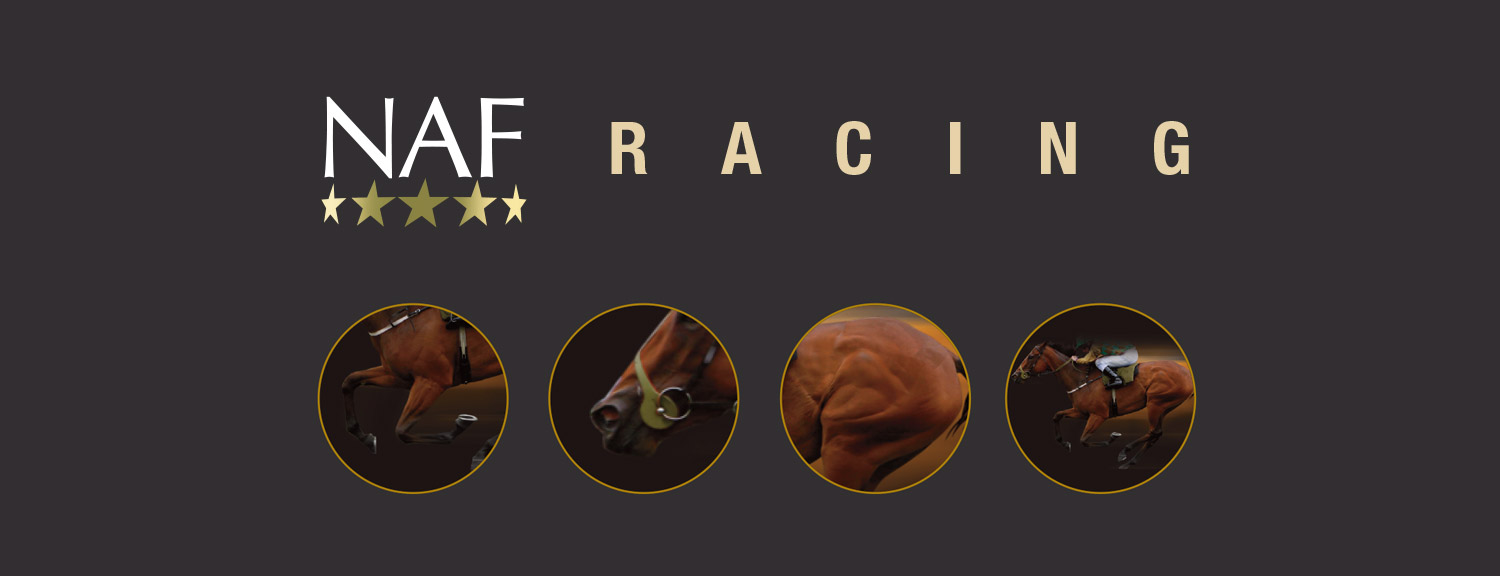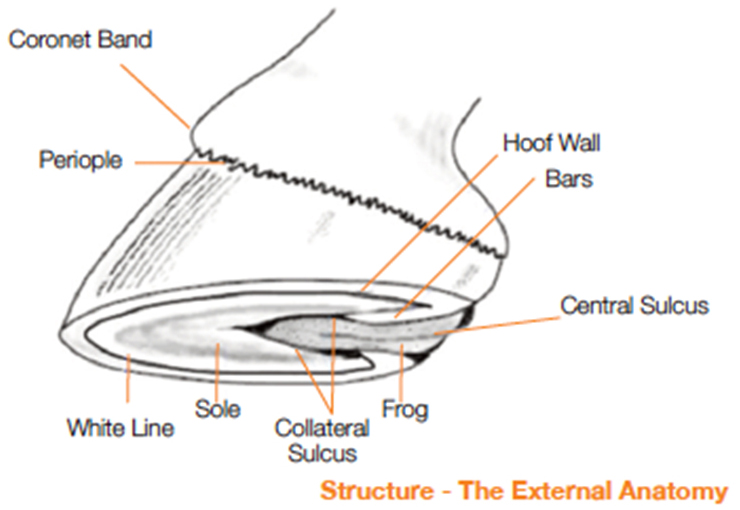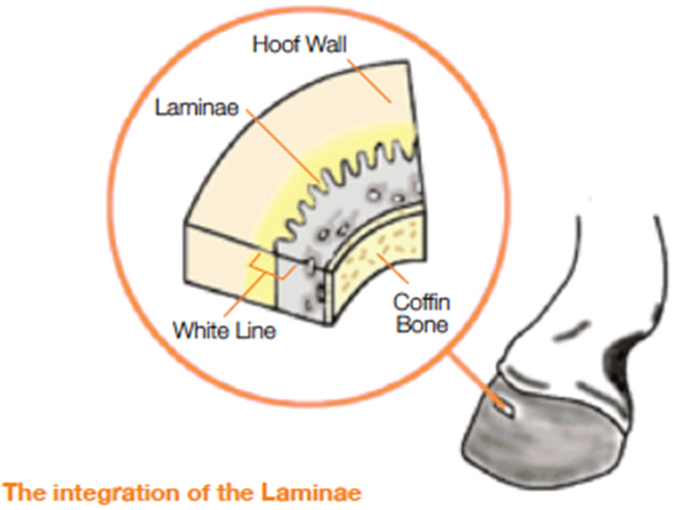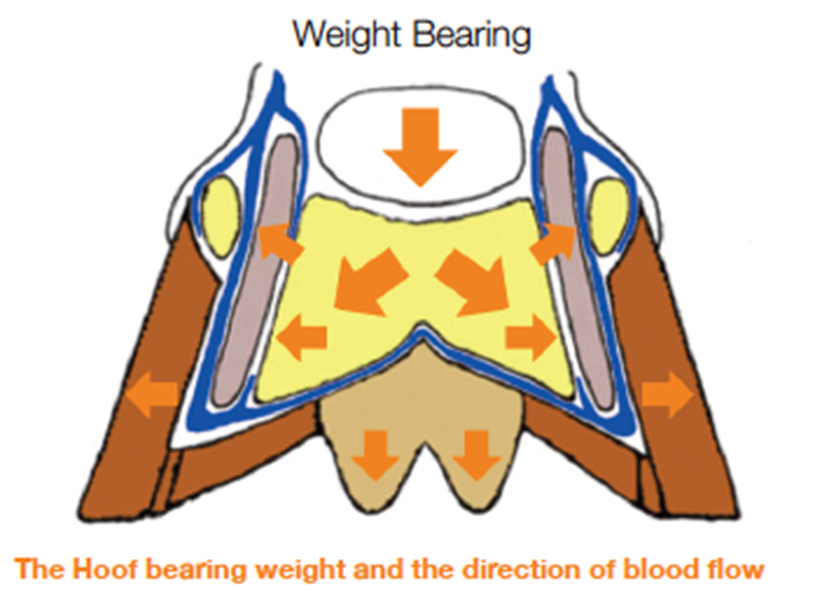



The saying ‘No foot, No horse’ is never more true than applied to racehorses. Lost shoes and hoof lameness can mean lost days training, and possibly even lost race days, so it is imperative we keep hooves sound and strong.
The purpose of the hoof wall is not only to protect the delicate inner structures, such as the laminae, tendons, digital cushion and bones of the feet, but also to play a vital role in performance and results. Thoroughbreds have been selectively bred to be a power-house up top, propelling forward off slender, relatively delicate, limbs. Luckily the unique design of the equine hoof is superbly adapted to absorb the significant concussive forces associated with galloping at speed, so keeping the horse sound and racing.
However, it is not just about preventing damage, but also maximising performance. The hoof is the only part of the horse to come into contact with the racing surface, and so is the final part of the powerful push forward through the stride – effectively propelling the horse forward. Without sound hooves, not only do we risk damage and lameness, but also we’re unlikely to maximise performance.
Foot soreness has been reported as the most common form of lameness in racehorses.
Racehorses have relatively small hooves to body-mass, with thinner walls and soles, when compared to other breeds.
Studies show hoof composition and strength may vary both between seasons and from one year to the next.
The Equus family are unique in that they are the only hooved animals that have evolved with a single toe. This makes them fast and athletic, but relatively delicate.
Hoof Growth
Slow growth may be due to a number of reasons but the lack of new hoof wall means that new nail holes are too close to the old ones so weakening the wall. In other cases, the rate of growth is fine but quality of horn is poor. Whether slow or poor growth, or a combination of both, the hoof is left cracking, crumbling and prone to having chunks missing out the bottom. Without healthy growth it becomes difficult for farriers to manipulate the shape of the hoof for performance, he or she is left just focusing on keeping the new shoe on. So a vicious circle ensues:
Factors affecting Hoof Condition
Working on surfaces is ideal for the horses’ joints, if possible, but do be aware that the type of surface can have a significant impact. Research looking to compare different designs of racing plate and different track surfaces, found that the type of plate had very little influence on the loading rate through the limb. The exception being the V-Grip plate which was found to reduce horizontal loading (craniocaudal) when galloping on synthetic surfaces of high wax content.
However, what was significant was surface type and its preparation; so it’s advised to pay particular attention to track quality and moisture levels to avoid excessive loading through the hoof and limb. Other factors such as temperature and weather will also have an effect though, perhaps, moisture has the greatest influence. Hoof moisture has a direct link to hoof quality and is continually evaporated from the hoof wall, meaning it must be replaced or compensated for. This is done in the first instance internally through the blood and lymph systems which can replenish moisture in the horn cells. However, the wall can also draw moisture from its environment, which depending on what the British weather is doing can be a great help or a hindrance!
Experienced farriers will advise providing daily external moisture for hooves, reducing effects of those environmental changes that may dry the hoof and lead to cracking. Access to a ford or river crossing will help, but also consider a daily topical application of a water-based moisturiser.
Hoof growth, like all systems in the body, can be hugely influenced by the right diet.
Biotin
The best known nutritional support for hooves is biotin (Vitamin H). Naturally biotin is synthesised in the horse’s own gut through bacterial fermentation of fibre. For racehorses where more of the diet is concentrate and cereal based, fermentation of fibre is reduced and therefore we may see a deficiency of microbially produced vitamins, such as biotin. Plus, the physiological stresses of regular travel and peak performance may also impact on digestive efficiency, so reducing absorption of gut produced vitamins.
If supplementing, ensure the correct level of biotin is being supplied for both the size of horse and their individual requirement. To support healthy growth in racehorses showing compromised foot health, we would advise 48mg of biotin daily. As biotin is not stored in the body, it may be necessary to supplement long term, particularly in hardworking horses. For maintenance of healthy hooves in racehorses, approximately 24mg biotin daily would be advised.
Sulphur
However, just as nothing works alone in nature, targeted nutritional support for hooves should go beyond biotin alone for best results. Look for a supplement which includes good sources of bioavailable sulphur, such as MSM and methionine, as the hoof wall is rich in sulphur. In fact, its the sulphur that gives hooves that characteristic smell of hot shoeing. Trace elements such as manganese and zinc are also indicated for hoof health, and are a useful addition to any hoof health supplement.
Zinc
The key trace element zinc is also advised for supplementary when targeting hoof health, as zinc plays an important role in the process of keratinization, so helping to grow strong hoof wall. Lastly look for support of the whole system. Hooves are part of the ‘dermis’, the largest organ in the body, and therefore the first to show the signs of the physiological stresses of performance training, travel and regular competition.
Manganese is useful as part of the MnSOD (Manganese Superoxide Dismutase) enzyme which works to protect cells internally, from oxidative stress. Look too for the antioxidant vitamins C and E with herbal support such as rosehip, omicha berries, marine algaes like chlorella and sources of natural fatty acids such as linseed, to ensure that your chosen supplement is supporting all aspects of hoof health for your team.
Conclusion
If there is quality growth, from a sound diet and good management, then the farrier’s job in maximising equine performance, is made so much easier.
Selected References
Mahafferty CA et al (2016) Dynamic testing of horseshoe designs at impact on synthetic and dirt Thoroughbred racetrack materials. Equine Veterinary Journal. Jan;48(1):97-102
Noormohammady et al (2018) Effect of zinc on integrity of horse hoof. Agricultural & Veterinary Sciences Vol.2, No.1, 2018, pp.17-23
Josseck et al (1995) Hoof horn abnormalities in Lipizzaner horses and the effect of dietary biotin on macroscopic aspects of hoof horn quality. Equine Veterinary Journal. May;27(3):175-82.

The External Anatomy of the Hoof
Good strong feet in racehorses are paramount to maintain performance, soundness and longevity throughout their career.
It takes around a year for the hoof to grow from coronet to toe which means any insufficient nutrition or injuries as well as other environmental factors may have a detrimental impact on the growth, health and horn development.
The structure of the hoof works to protect, nourish and serve the horse.

The hoof wall is made up of horny tissue called Keratin that has a moisture content of 25% without any nerves or blood vessels and around 6 – 12mm thick. Keratin is made up of a series of vertically aligned tubules held together by hydrogen bonds, these are strong when conditions are dry, however, when the hoof absorbs water from the external environment, the bonds can be weakened and even broken. This can not only weaken the hoof’s structure but affect the shock absorbing qualities. The hoof wall encases the sensitive internal hoof structures and hoof tissues while working to dispel concussion and provide a surface to grip on throughout the different terrains. The hoof wall is thickest at the toe and thinner at the heel, ideally hooves should have a nice rounded toe and a wide heel base - signs of a narrow heel could suggest navicular disease.
The hoof wall is unable to expand and should damage occur, the result is quite simply lameness. A healthy hoof should not have any cracks, splits or rings. Cracks can open the way for gravel and/or dirt to enter which carries germs and bacteria, while rings can mean that there could be additional health problems, which should be investigated.
The coronary band sits at the top of the hoof wall and is the source of growth while providing essential nutrition for the hoof wall. Should injury occur to the coronet band it can result in damage to the hoof wall, which may affect hoof growth and the longevity of the horses ridden career. The periople sits below the coronary band comprising of recently formed hoof tissue to give it time to stabilise before growing onto the hoof wall. The laminae layer helps to protect the inner parts of the hoof and supports the laminae which attached the coffin bone to the inside of the hoof wall. The laminae bear the majority of the weight and are an integral part of the hoof.

The sole is the bottom of the hoof that that is frequently worn down due to the type of keratin. This works to protect the internal hoof structures while helping to bear the internal weight. The white line tissues attach the sole to the inner wall of the hoof, should this area become compromised separation can occur which can be detrimental to performance. The frog protects the digital cushion and acts as a shock absorber helping to aid circulation within the hoof itself. Some people often refer to the frog as the “heart” of the hoof.
Bars are located by the bulbs of the heel and help to further absorb concussion and energy, quite simply they are an extension of the hoof wall that finish part way along the sides of the frog. When you pick out hooves it is common practice to run the hoof pick down each side of the frog known as the collateral sulcus (groove) and gently down the middle clearing any debris, this is referred to as the central sulcus. Wet conditions can often soften and weaken these areas which can harbour hidden debris leading to potential outbreaks of thrush.
The external structure of the hoof works to protect and maintain soundness with the internal framework retained within. From the pedal bone to the navicular bone contained within the hoof along with the hugely important digital cushion. People often forget about the vast network of blood vessels and nerves which allow the horse to literally feel their environment and continue to pump the blood back up the leg and around their body.

A breakdown in wellbeing, stress, nutritional deficiencies or genetic disposition can indeed result in poor hoof growth, horn quality and the essential structures as mentioned can be put at risk. This not only could lead to soundness issues but will without doubt be a performance limitation and indeed result in, "No foot, No horse."
NAF © 2024 | NAF is a trading name of Greencoat Limited, registered in England & Wales. Greencoat Ltd - Registered address: Weston Centre, 10 Grosvenor Street, London, W1K 4QY. Registered Number: 1560 108. Registered in England & Wales.Number: 1560108 VAT Registration Number: 378 9295 80